"Hawker Hurricane"
11 February 1938 on the front pages of British newspapers enthusiastically reported that the day before one of the Hawker fighters, Hurricane, which was piloted by J.W. Gillan, covered 526 km in 48 minutes at an average speed of 658 km /hour. This was the beginning of the glorious career of Hurricane, which was among the most famous fighters in the world. It was produced in large series (in total, more than 14500 units were manufactured during the production of aircraft of this family) and participated in battles on all fronts of the Second World War.
In the mid-thirties, the leadership of the Arms Directorate of Great Britain set a task for aircraft designers: to create a fighter capable of reaching speeds of 300 miles per hour armed with eight rifle-caliber machine guns (F.5 / 34 specification). By the fall of 1934, the chief designer of the Hawker firm (known as Sopwich since the days of the First World War), Sydney Kamm, presented the design of such a fighter.
The project was studied in detail by leading experts of the National Physical Laboratory and received a positive assessment. However, on September 4, 1934, the Ministry aviation developed a new specification, designated "F.36 / 34 Single-seat high-speed monoplane fighter." The company finalized its project, and on February 18, 1935, an agreement was signed on the construction of an experimental machine, which received serial number K 5083.
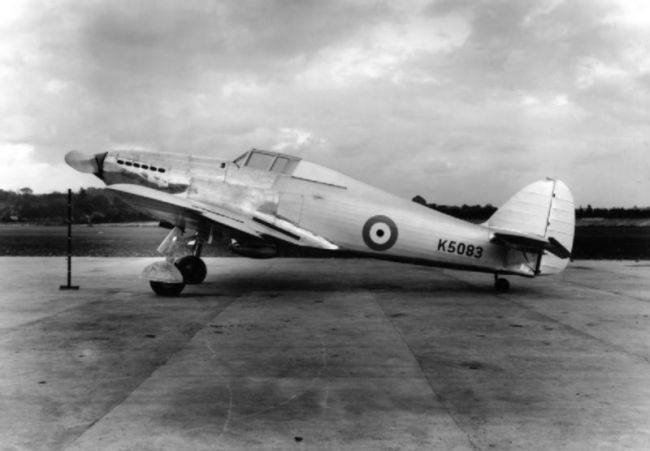
Six weeks later, the prototype was ready. Without weapons. The Rolls-Royce P.V.12 aircraft engine (later received the designation “Merlin C”) did not pass certification. Only in August, they received a certificate for the 50-hour engine operation, which they installed on the aircraft.
The basis of the fuselage design was a box-shaped truss, assembled from round tubes, with internal wire reinforcement. To give the necessary contours in the rear fuselage on the farm was installed 11 plywood frames, connected by wooden stringers. The nose of the fuselage was sheathed with aluminum sheet, and the rear canvas. The wings were also trimmed with linen. The machine had a two-bladed wooden propeller fixed pitch. The plane flew the pilot George Bulman 6 November 1935 of the year. When testing, the car showed the speed of 506 km / h at the height of 4940 m at 2960 revolutions per minute. He gained the height of 4570 in 5,7 minutes, and 6096 in 8,4 minutes.
However, deficiencies in various systems, including in the engine and chassis, were revealed. After their removal, 3 June 1936 of the year entered into an agreement to supply 600 aircraft, and 27 June the Ministry of Aviation assigned the name "Hurricane" ("Hurricane") to the fighter. Its production was launched at once in two factories. The first production aircraft received a registration number 1547. In December 1937, a nine of the Hurricanes entered service with the 111 th Fighter Squadron of the Royal Air Force.
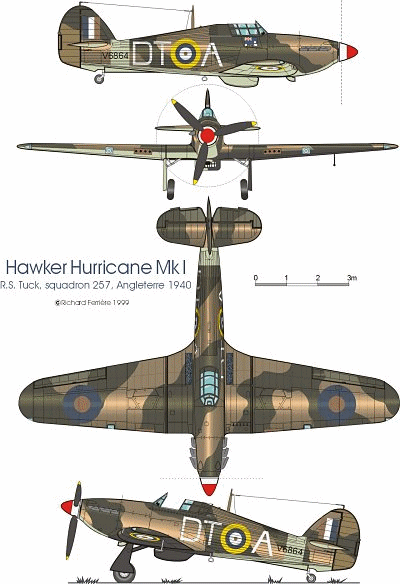
Serial machines externally did not differ from the prototype. The design of the fuselage remained the same. They were completed 12-cylinder liquid-cooled engine "Merlin" II with a supercharger. On serial aircraft for each pair of cylinders installed one exhaust pipe. The cockpit was separated from the engine by a reinforced fire bulkhead. Behind the pilot's seat was an armored backrest. All aircraft were equipped with radio equipment.
The armament consisted of eight machine guns "Browning" rifle caliber with 334 ammunition cartridge on the barrel. The gates of the machine guns were cocked by means of a pneumatic system. The collimator sight was mounted, but on most airplanes an external front sight was mounted on the hood additionally.
Aircraft improved. Its speed increased to 521 km / h at an altitude of 4982 m and 408 km / h from the ground. The normal weight of the machine was 2820 kg, fuel supply 262 kg (350 l), combat radius 684 km. The wing paneling of the wings was later completely replaced by metal.
For 1938, the X. NUMX of Hurricane Mk.220 machines were produced, which staffed ten divisions of the Royal Air Force. New English fighter interested and a number of foreign countries. Yugoslavia was the first to ask Britain to sell modern fighters to it. The British did not refuse. 1 "Hurricanes" Mk.12 from the number of 1 ordered for their Air Force, they allocated to the Yugoslavs. In December 600, the first two aircraft arrived at the new owner. In 1938, the contract was signed for the construction of Hurricanes М.1940 in Yugoslavia, and at the same time at two factories, in Zagreb and Zeman. It was also decided to additionally deliver 1 aircraft from England.
In the autumn of 1938, during his visit to the UK, the Romanian king agreed to supply his country with 12 fighters during the 12 months.
In the same year, the delivery of the Hurricanes Mk.1 to Canada, then the dominion of Britain, began. And in 1939, the production of new fighters was launched in this country (a total of 1451 aircraft was built there).
The government of Persia asked 18 Hurricanes to be sold to it. Consent received, but only two cars hit the customer. In the same year, the Turkish government ordered a tropical version of the 15 “Hurricanes” Mk.1, then it was increased to 28.
Belgium was supplied 20 pieces with the new "Merlin" III. A three-blade propeller of fixed rotations “Rothol” was installed on two airplanes.
The growing demand for Hurricanes forced them to increase their production. A contract was made for another 300 aircraft. New engine "Merlin" III power in 1030 hp with a two-stage supercharger and new three-blade propellers "De Havilland" or "Rothol", the metal skin of the wing raised the rating of this fighter even higher.
Since the beginning of World War II, in addition to Hawker, production of Hurricanes was launched at the Gloucester plant. She was assigned to release the 500 Hurricanes Mk.1.
Since the beginning of the Soviet-Finnish war, Britain sent 12 “Hurricanes” Mk.1 to Finland, some of which were prepared as early as the autumn of 1939 of the year to be sent to Poland. However, these fighters did not have time to war with the Finns. By the time they were ready, the war was over.
Battle baptism "Hurricanes" took in France. The Air Force Expeditionary Force of the United Kingdom initially included two divisions. A little later, their number increased to four.
From 9 April to the end of May - 1940 of the year in battles for France and Norway, the Royal British Air Force lost 949 aircraft, including 477 fighters, 386 of which were Hurricanes.
On 1 June 1940, Britain had first line fighters in service with 905. In July, the “Battle of England” began. In the ten days of July, German aircraft lost 36 bombers, of which the Hurricanes shot down 13. At the same time, the British pilots also destroyed 7 fighters and one scout, losing only their 8. In July, the Hurricane pilots shot down 49 bombers, 12 Me-109 and 14 Me-110, as well as 12 of other aircraft. During this same time, the Hurricane 40 was lost, with two aircraft shooting down their anti-aircraft gunners.
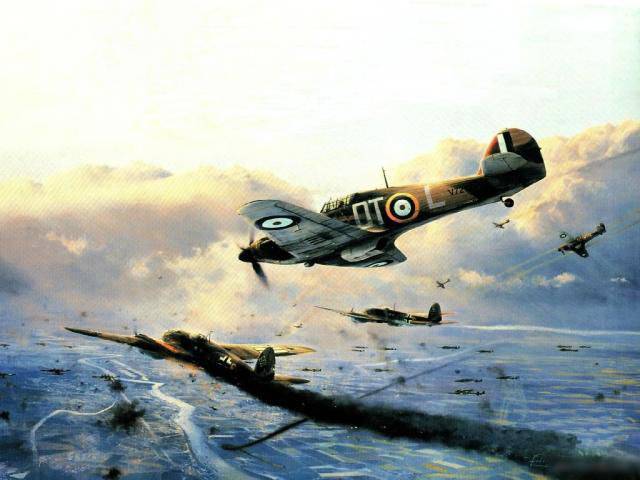
Air battles showed that the Hurricane was inferior to the German Me-109 in speed and vertical maneuverability, and most importantly - in fire power.
Hawker designers decided to put a new 20 1280 engine in the 3000 hp on the plane at 518 revolutions per minute. The upgraded aircraft showed a speed of 4100 km / h at an altitude of 2495 m. The weight of the empty machine was 12 kg. Armament has not changed. The upgraded aircraft received the designation "Hurricane" Mk.IIA. The fighter version was tested with 7,7 3990 caliber 113,4 Browns and XNUMX ammunition. "Hurricanes" with such weapons received the designation Mk.IIV. However, it was still hard to compete with German fighters (machine guns of this caliber did not penetrate the armor of German aircraft). They used the Mk.IIA as night and sea fighters, and the Mk.IIV as fighter-bombers. In the bomber version, under each wing, one bomb weighing XNUMX kg was suspended. The Hurricane fighters were well mastered by industry, and the War Department sought to prolong their lives. But for this it was necessary to strengthen the weapons.
Subsequently, the designers managed to place in the wings four 20-mm guns "Oerlikon" or "British-Hispano". There have been some changes in the equipment of the machine. The aircraft showed the speed of 550 km / h at the height of 6700 m and had a normal weight 3538 kg, the ammunition was 364 projectile. He was given the designation Mk.IIC.
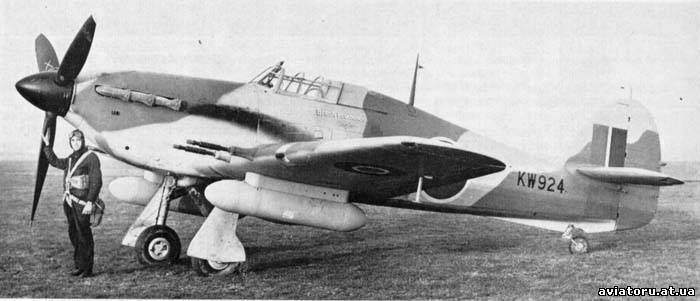
On Hurricanes, Mk.IIB and C began to install photo-guns to record the results of the shooting. Over the years, the serial production has been produced 4711 copies of the Mk.IIC.
Work was also underway to install three-inch rockets under the wing, but this innovation did not take root. For the destruction of armored targets under each wing on one of the modifications installed 40 mm tank gun "Vickers-S". Her ammunition was 16 shells. In addition to two guns, the aircraft was also armed with two 7,7-mm Browning sighting machine guns with an ammunition load of 660 rounds. This "Hurricane" received the designation MK.IID. The first cars of this series appeared at the front in March 1942 in Egypt as part of Division 6.
The latest production model was the Hurricane Mk.IV. This fighter differed from the MKIID model by the presence of armor protection of a number of vital units, as well as by more powerful weapons (the aircraft was able to carry a pair of 227 kg bombs or 8 three-inch missiles). The new modification was equipped with the 24 “Merlin” engine or the 27 “Merlin”, which have the power in 1620 hp. But at the same time, the aircraft practically lost its destructive properties. Normal weight reached 3490 kg, and the speed dropped to 426 km / h. It is not surprising that he did not find wide application. Total 524 made an instance of this modification.
In order to cover the sea convoys, they began to redo a part of the released Hurricanes into the model "Sea Hurricane". They differed only in radio equipment and color. The part of "Sea Hurricanes" was equipped for a one-time launch from the transport ships with the help of a catapult. After completing the task, the pilot had to leave the plane with a parachute or land on the surface of the water near his ship. This is not a good life: badly lacking aircraft carriers. Later on the "Sea Hurricanes" mounted landing hook, which allowed landing on aircraft carriers, including escort. It should be noted that the "Sea Hurricanes" Mk.IIC very successfully solved the problem of repelling attacks by German bombers, who did not have fighter cover. Powerful cannon weapons posed a threat to small craft and ships.
“Sea Hurricanes” from March 1942, began to accompany the convoys going to the Soviet Union. In winter, the 1941 of the year around the 100 of the C.H. Hurricane fighters of the MK.1W were re-equipped with the Merlin engine. Instead of wing machine guns mounted four 20-mm guns. These aircraft received the designation Mk.1С. "Sea Hurricane" Mk.1С developed speed 476 km / h at altitude 4600м.
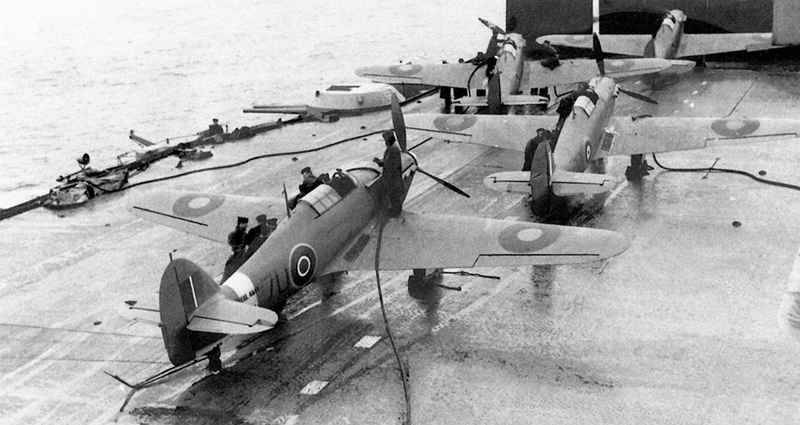
The British Spitfire, as well as American-made fighters, forced the Hurricanes out of the metropolis. But they continued to be actively used in North Africa, and then, from the end of 1942, and in Indochina.
In the summer of 1943 in Indochina, the 19 divisions fought on the Hurricane Mk.IIV and C. At the end of the 1943, there were 970 "Hurricane", including the 46 Mk.1 of the Indian Air Force. Hurricanes were also used for tactical intelligence. These machines were supplied with a camera.
The Indian Air Force, the British transferred around 300 "Hurricane" of various brands (Mk.IIV, C, XII). 19 "Hurricanes" Mk.1B and Mk.IIC were transferred to Ireland, 14 Mk.IIC to Turkey (in 1942 year) and 10 fighters to Iran, which after the end of the war received an additional 16 "Hurricanes" Mk.IIC.
Delivered to other countries, including the USSR. It was the Hurricanes that were the first Allied combat aircraft delivered to the USSR. It must be said that in the winter of the 1941 of the year, when most of the Hurricanes were sent to the USSR, the Soviet Air Force experienced a tremendous need for modern aircraft. Of course, in comparison with I-15 and similar archaisms, Hurricane was a step forward. But by the beginning of 1942, they were inferior to German cars in all respects. With the saturation of the Soviet air force with new domestic fighters, the lag of the Hurricane became even more pronounced.
Soviet technicians and engineers tried, as best they could, to improve the characteristics of the British aircraft. Many changes in the composition of the armament were carried out in the field conditions of front-line airfields even before the start of the official modernization program. Machine guns "Browning" rifle caliber were replaced with 12,7 machine guns UBC. Guides for PC-82 missiles were installed, sometimes even ShVAK cannons were mounted. It was not uncommon for Hurricane equipment to be four or six PC-82. Improved by our mechanics and booking. In the field, the factory armor of the Hurricane was replaced with armored seats, dismantled with the I-16. In total, according to British data, 20 "Hurricanes" Mk.IIA, 1557 Mk.IIB, 1009 Mk.IIC, 60 Mk.III and 30 Mk.IV. were sent to the Soviet Union.
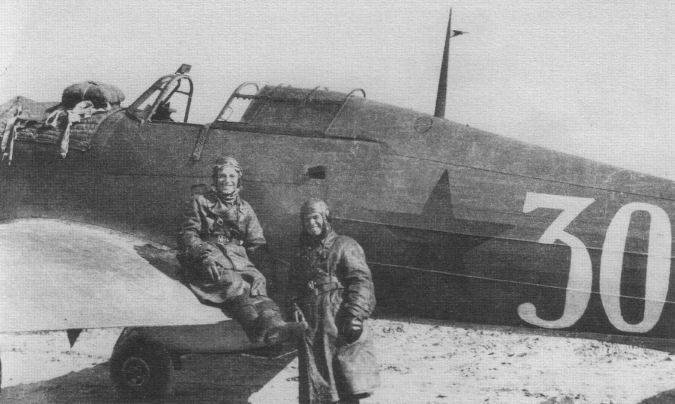
After the war, the British government, in honor of the 600 anniversary of the conclusion of the treaty with Portugal, transmitted the last 50 "Hurricanes" McIc in tropical design (they were supposed to be used in the Azores). Of them, the Merlin -40 engine was installed on 22. These aircraft were in service with the Portuguese Air Force until 1951.
In addition to British factories, Hurricanes were produced in Canada, in the city of Montreal with the Merlin II and III engines. From November 1940 of the year to April, the 1941 of the Mk.I series with the Packard Merlin 340 was released there. Moreover, the 28 aircraft had eight wing machine guns, and the aircraft with numbers AC320-AC665 were armed with either 684 machine guns or 12 guns. More than 4 aircraft that received the designation of the Mk.Kh and Mk.KhI, corresponded to the Mk.IIV and Mk.IIC with the Merlin 300 engine. One hundred and seven of them were sent to the USSR. The latest model of the Canadian "Hurricane" received the designation Mk.XII. It installed the engine "Packard Merlin" 28. Two modifications were produced: XIIV with machine guns and XIIC with cannon. A total of Canada produced 29 "Hurricane" Mk.480 and more 1 "Hurricane" Mk.X, Mk.XI and Mk.XII.
The Hurricane Fighter was used for various experiments. For example, to increase the flight range of an aircraft, such an option was worked out. The fighter was fastened with a loop of a cable of the required length, which was fastened to the front edge of the wing to the front edge of the wing, and the middle for a special clip located under the fuselage. After climbing, the pilot opened the clamp, and the loop was released. The fighter occupied a position behind the tail of the bomber. From the latter a special cable with a hook was produced. This hook hooked the loop, the bomber added speed, and the fighter pilot jammed the engine and the wind blade propeller. In the event of the appearance of the enemy, the fighter launched the engine and unhooked from the towing vehicle. But this innovation has not gone to a series.
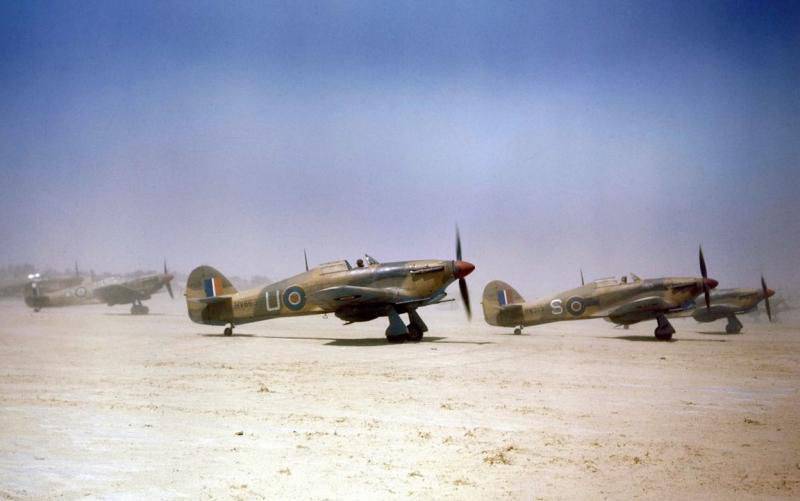
In the 1940 year, attempts were made to put the Hurricane on the float. However, the fighter showed low speed, only 322 km / h.
The British tried to install aircraft engines of other designs on the aircraft. For example, in the midst of the “Battle of England”, in October, a fighter prepared for pilot training was mounted on the 1940 of October, equipped with a cheaper and more technologically advanced Nzpyr Dagger engine. The following year, the Rolls Royce IIA and Hercules motors were installed on two experimental machines. In addition, one of the Yugoslav licensed "Hurricanes" received the engine "Daimler Benz."
In March, the 1942 of the year passed the Hurricane test with a flashlight similar to those used on Spitfire fighters. But it was considered inexpedient to launch it into production, and the use of the Hurricanes as fighter-bombers did not require an improvement in the quality of the flashlight. Especially for Iran in 1945 year built two copies - double "Hurricane". These aircraft were equipped with two cabins. The front cockpit did not have a lantern, and the back had one (the lantern of the type used on the “tests”). Radio equipment was not installed.
Many Soviet aces fought on the Hurricanes. So, for example, 31 of May 1942, the famous pilot Amet-Khan Sultan, leading the battle on Harikkein, spent ammunition, but could not shoot down Ju 88 near Yaroslavl. Then the brave pilot destroyed the enemy with a ram attack. The following month, he shot down two more Messers and one Ju-87 on the North-Western Front. Hero of the Soviet Union S.F. also flew on the Hurricanes. Dolgushin, who shot down five Nazi planes in the English fighter.
Five to seven downed enemy vehicles had many pilots of the 4-IAP in their combat score. Pilot Stepanenko scored seven victories, and all of the downed planes were fighters. During the spring of 1942, the lieutenant of the 48-IAP Yu. Bakharov won seven individual and five group victories during the battles.
But the most productive pilots "Hurricanes" were sailors. Famous ace Boris Safonov destroyed 11 enemy machines. Senior Lieutenant P. Zgibnev and Captain V. Adonkin, who fought on the Northern Front, had victories for 15.
However, our pilots rarely spoke good words about Harikkeyn. The aforementioned Dolgushin wrote: "Hurricane" is an abominable plane. The speed is low, heavy itself ... I shot down five enemy aircraft on this fighter, but for these victories I needed special conditions. ”
However, it should not be forgotten that the Hurricanes helped our army survive the most difficult period of the war. Therefore, this fighter is a piece not only of English, but also of ours. stories.
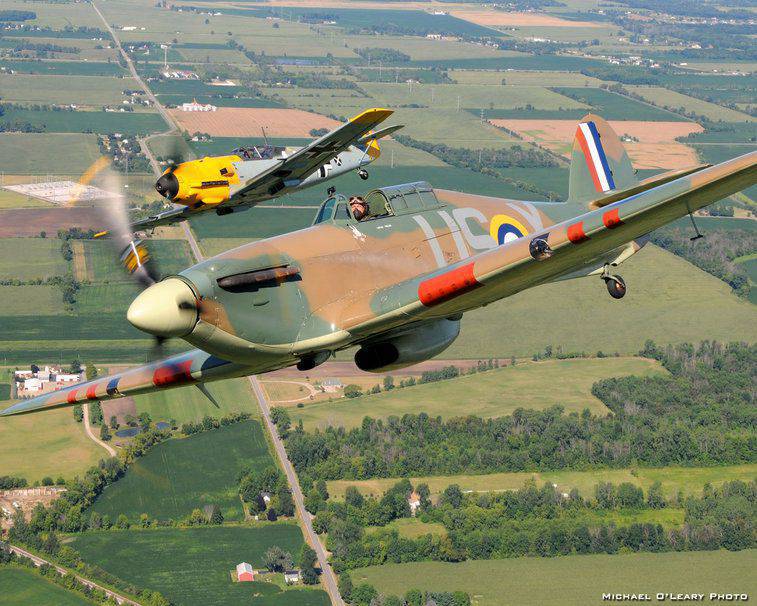
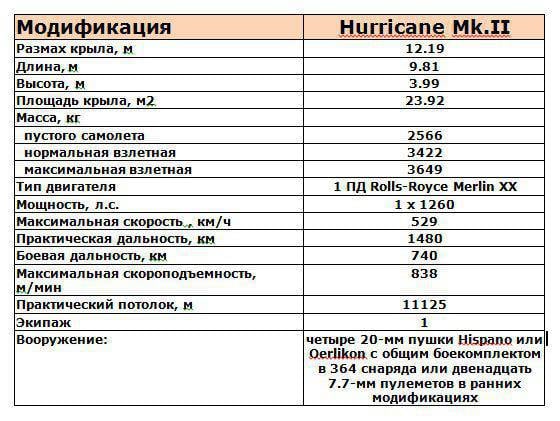
Sources:
Kotelnikov V. Fighter Hawker "Hurricane" // Aviation and Astronautics. 2007. No.5. C.3-8, 28-32.
Kolesnikov S. Lika "Hurricane" // Wings of the Motherland. 1992. No.12. C. 22-25.
Kondratyev V. "Hurricane" over the battlefield // Model-designer. 1990. No.3 C.17-20.
Danielle J. March. British military aircraft of World War II. M .: AST, 2002. C. 150-158.
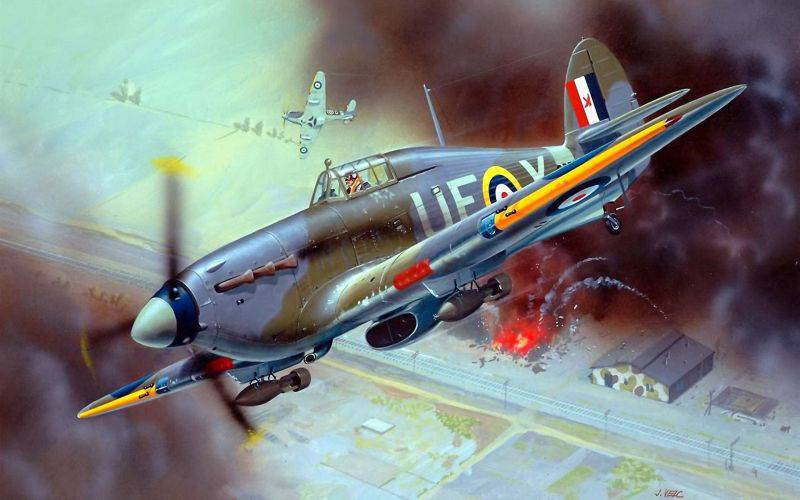
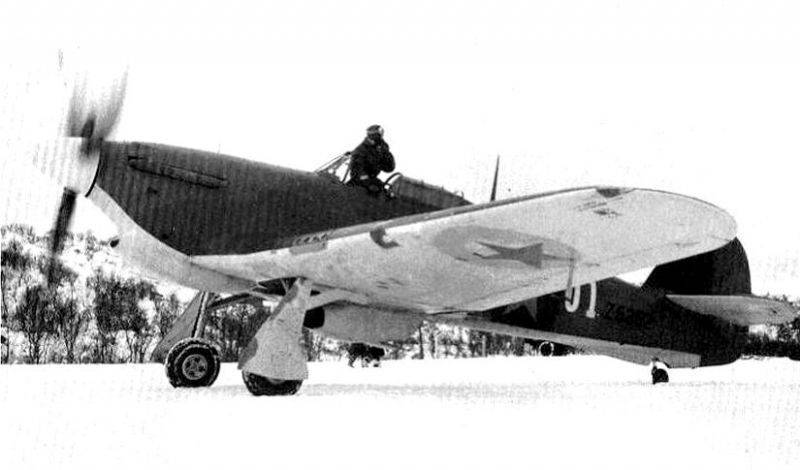
Information